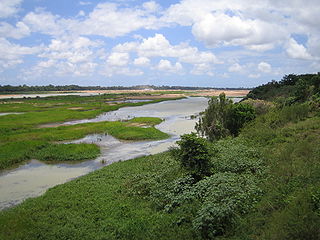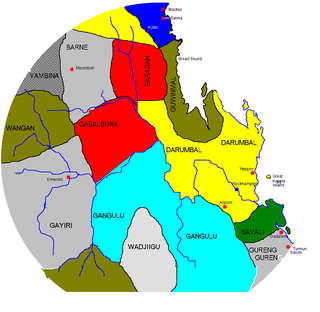
The Shire of Burdekin is a local government area located in North Queensland, Australia in the Dry Tropics region. The district is located between Townsville and Bowen in the delta of the Burdekin River. The shire covers an area of 5,044 square kilometres (1,947 sq mi). It has existed as a local government entity since 1888. In the 2021 census, the Shire of Burdekin had a population of 16,692 people.

The Burdekin River is a river in North and Far North Queensland, Australia. The river rises on the northern slopes of Boulder Mountain at Valley of Lagoons, part of the western slope of the Seaview Range, and flows into the Coral Sea at Upstart Bay over 200 kilometres (124 mi) to the southeast of the source, with a catchment area of approximately 130,000 square kilometres (50,000 sq mi). The Burdekin River is Australia's largest river by (peak) discharge volume.

North Queensland or the Northern Region is the northern part of the Australian state of Queensland that lies just south of Far North Queensland. Queensland is a massive state, larger than many countries, and its tropical northern part has been historically remote and undeveloped, resulting in a distinctive regional character and identity.
The Gidabal, also known as Kitabal and Githabul, are an indigenous Australian tribe of southern Queensland, who inhabited an area in south-east Queensland and north-east New South Wales, now within the Southern Downs, Tenterfield and Kyogle Local Government regions.
The Ngaro are an Australian Aboriginal group of people who traditionally inhabited the Whitsunday Islands and coastal regions of Queensland, employing a seafaring lifestyle in an area that archaeologically shows evidence of human habitation since 9000 BP. Ngaro society was destroyed by warfare with traders, colonists, and the Australian Native Police. The Native Police Corps forcibly relocated the remaining Ngaro people in 1870 to a penal colony on Palm Island or to the lumber mills of Brampton Island as forced labourers.
The Darumbal people, also spelt Darambal and Dharumbal, are the Aboriginal Australian people who have traditionally occupied Central Queensland, speaking dialects of the Darumbal language. Darumbal people of the Keppel Islands and surrounding regions are sometimes also known as Woppaburra or Ganumi, and the terms are sometimes used interchangeably.

The Uutaalnganu people, also known as Night Island Kawadji, are an Aboriginal Australian group of Cape York Peninsula in northern Queensland. The name is also used collectively for several peoples in this area, such as the Pontunj / Jangkonj (Yanganyu), whose language is unconfirmed.
The Wangan are an Aboriginal Australian people of the Isaac Region of Central Queensland.

The Gabulbarra people, also rendered Gabalbura, Gabalbara and Kabalbara, were an Aboriginal Australian people of an area in eastern Central Queensland, but there is little recorded information about them.
The Gia people, also known as Giya, Kia, Bumbarra, and variants, are an Aboriginal Australian people of the state of Queensland. Little is known of them.
The Birri Gubba people, formerly known as Biria, are an Aboriginal Australian people of the state of Queensland.
The Wiri are an Aboriginal Australian people of an area on the eastern side of the state of Queensland. They speak a dialect of the Biri language called Wiri.

The Koinmerburra people, also known as Koinjmal, Guwinmal, Kungmal and other variants, are an Aboriginal Australian people of the state of Queensland. They are the traditional owners of an area which includes part of the Great Barrier Reef.
The Dingaal people, also known as Walmbarddha or Walmbaria, are an Aboriginal Australian people of Cape York Peninsula in northern Queensland.
The Geynyon, also written Keinjan, are an indigenous Australian people of southern Queensland. According to research done by Queensland South Native Title Services (QSNTS) entitled South East Regional Research Project (SERRP) 'Geynyan' are in all likelihood an dialect/estate group of the wider Githabul peoples. In May 2021 the Githabul peoples lodged a Native Title claim over much of the former Warwick Shire within the Southern Downs Regional Council area.

The Baradha people, also spelt Barada and Thar ar ra burra, and also known as Toolginburra, were an Aboriginal Australian people of Central Queensland not far inland from the east coast.
The Kareldi was a name assigned by Norman Tindale to Aboriginal Australian peoples of the state of Queensland. There were two groups that went by this name, the Garandi (Karandi), after the Garandi language, and the Gkuthaarn, after the Gkuthaarn language. It is not clear if they constituted a single people, but it appears that there were two dialects in the same area.
The Yangga, also spelt Jangga, are an Aboriginal Australian people of the state of Queensland. They are not to be confused with the Yanga people.

The Bindal are the Aboriginal Australian people whose ancestors originally possessed, occupied, used and enjoyed approximately 2600 km2 of coastal country from the mouth of the Burdekin River north to Cape Cleveland, inland to Leichhardt Range, in the state of Queensland
The Kukatj are an Aboriginal Australian people of the Cape York Peninsula in the state of Queensland. They are to be distinguished from the Kukatja of Western Australia and the Luritja of the Northern Territory, who have also historically been known as Kukatja.